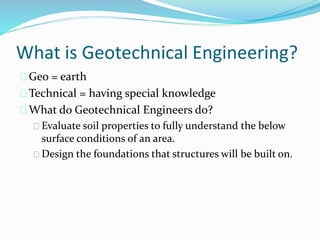Things about Geotheta
Things about Geotheta
Blog Article
Some Ideas on Geotheta You Should Know
Table of ContentsThe Main Principles Of Geotheta Geotheta for BeginnersExcitement About GeothetaNot known Factual Statements About Geotheta Unknown Facts About Geotheta

They carry out site examinations, accumulate examples, execute laboratory examinations, and evaluate data to assess the viability of the ground for construction tasks - Tailings Engineer. Based upon their searchings for, geotechnical engineers offer suggestions for foundation style, slope stability, preserving frameworks, and reduction of geotechnical risks. They team up with other specialists, such as designers, structural designers, and construction groups, to make sure that geotechnical considerations are integrated right into the total job style and application
By analyzing the habits and homes of soil and rock, they can identify possible geotechnical threats such as landslides, dirt negotiation, or incline instability. Their competence aids protect against failures or accidents that might threaten lives and property. Here are some detailed responsibilities and responsibilities of a geotechnical designer: Site Investigation: Geotechnical engineers conduct site examinations to gather data on subsurface conditions.
They interpret the data to recognize the residential properties and actions of the dirt and rock, including their stamina, permeability, compaction qualities, and groundwater conditions. Geotechnical Analysis and Design: Geotechnical designers examine the information accumulated throughout website investigations to examine the security and suitability of the website for building jobs. They do geotechnical estimations and modeling to examine variables such as birthing capability, settlement, slope security, side earth stress, and groundwater circulation.
Indicators on Geotheta You Need To Know
Structure Style: Geotechnical designers play a critical role in creating structures that can securely support the designated framework. They analyze the dirt conditions and tons requirements to identify the suitable structure kind, such as shallow foundations (e.g., footings), deep structures (e.g (https://anotepad.com/note/read/ew8kqmw7)., piles), or specialized methods like dirt renovation. They consider aspects such as negotiation limitations, birthing capability, and soil-structure interaction to establish ideal foundation layouts
They assess building and construction plans, display website activities, and perform area inspections to confirm that the design recommendations are complied with. If unpredicted geotechnical issues develop, they analyze the scenario and supply referrals for removal or modifications to the layout. Threat Assessment and Reduction: Geotechnical designers evaluate geotechnical dangers and dangers connected with the task site, such as landslides, liquefaction, or soil erosion.

Partnership and Communication: Geotechnical designers work closely with other specialists associated with a task, such as architects, architectural designers, and building teams. Effective interaction and collaboration are important to integrate geotechnical factors to consider into the total job layout and building and construction process. Geotechnical designers supply technical competence, solution inquiries, and make sure that geotechnical needs are satisfied.
Rumored Buzz on Geotheta
Right here are some sorts of geotechnical engineers: Foundation Designer: Structure designers specialize in creating and examining foundations for frameworks. They assess the dirt problems, lots requirements, and site attributes to establish the most appropriate foundation type More about the author and design, such as shallow foundations, deep structures, or specialized strategies like heap foundations.
They review the factors influencing incline stability, such as dirt residential properties, groundwater conditions, and slope geometry, and develop techniques to stop slope failings and mitigate threats. Quake Designer: Quake engineers concentrate on assessing and developing frameworks to withstand seismic pressures. They examine the seismic danger of a site, assess dirt liquefaction potential, and create seismic layout requirements to make sure the safety and strength of structures throughout earthquakes.
They perform field screening, gather examples, and examine the gathered data to identify the dirt homes, geologic developments, and groundwater conditions at a site. Geotechnical Instrumentation Designer: Geotechnical instrumentation designers concentrate on tracking and measuring the habits of soil, rock, and frameworks. They mount and preserve instrumentation systems that monitor aspects such as soil negotiation, groundwater degrees, slope movements, and architectural variations to assess performance and offer early cautions of possible issues.
Geotheta Things To Know Before You Buy
They carry out examinations such as triaxial tests, consolidation tests, direct shear examinations, and permeability tests to collect data for geotechnical analysis and layout. Geosynthetics Engineer: Geosynthetics designers specialize in the design and application of geosynthetic materials, such as geotextiles, geogrids, and geomembranes. They make use of these materials to boost soil security, strengthen inclines, give water drainage options, and control erosion.
They tend to be investigative individuals, which implies they're intellectual, introspective, and curious. They are curious, systematic, reasonable, logical, and logical. Some of them are additionally social, suggesting they're kind, charitable, participating, person, caring, helpful, compassionate, tactful, and pleasant - Consulting Engineer.
In the workplace atmosphere, geotechnical designers make use of specialized software program devices to execute estimations, produce styles, and evaluate data. They prepare records, review project requirements, communicate with customers and group members, and coordinate project tasks. The workplace setting offers a conducive setting for research study, analysis, and collaboration with various other professionals associated with the job.
Getting My Geotheta To Work
They frequently visit job sites to conduct website examinations, evaluate geotechnical problems, and gather data for evaluation. These sees involve traveling to various areas, occasionally in remote or challenging surfaces. Geotechnical designers may do dirt sampling, conduct examinations, and monitor building activities to make certain that the geotechnical aspects of the task are being carried out properly.
Geotechnical designers also operate in specialized geotechnical labs. In these facilities, they carry out experiments, perform tests on soil and rock samples, and examine the design buildings of the products. Geotechnical research laboratory engineers work extensively in these settings, handling testing equipment, running tools, and recording information. They collaborate with other laboratory staff to make sure precise and reliable testing outcomes.
Report this page